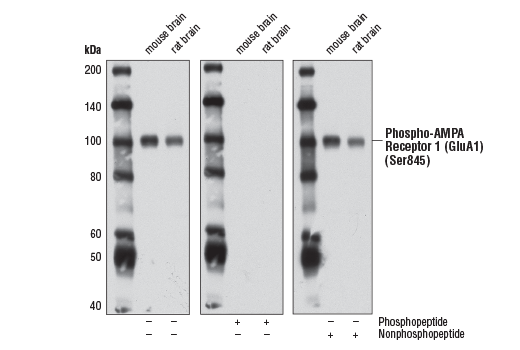WB, IP
H M R
Endogenous
100
Rabbit IgG
#P42261
2890
Product Information
Product Usage Information
| Application | Dilution |
|---|---|
| Western Blotting | 1:1000 |
| Immunoprecipitation | 1:50 |
Storage
Specificity / Sensitivity
Species Reactivity:
Human, Mouse, Rat
Source / Purification
Monoclonal antibody is produced by immunizing animals with a synthetic phosphopeptide corresponding to residues surrounding Ser845 of human AMPA Receptor 1 (GluA1) protein.
Background
AMPA- (α-amino-3-hydroxy-5-methyl-4-isoxazolepropionic acid), kainate-, and NMDA- (N-methyl-D-aspartate) receptors are the three main families of ionotropic glutamate-gated ion channels. AMPA receptors (AMPARs) are comprised of four subunits (GluR 1-4), which assemble as homo- or hetero-tetramers to mediate the majority of fast excitatory transmissions in the central nervous system. AMPARs are implicated in synapse formation, stabilization, and plasticity (1). In contrast to GluR 2-containing AMPARs, AMPARs that lack GluR 2 are permeable to calcium (2). Post-transcriptional modifications (alternative splicing, nuclear RNA editing) and post-translational modifications (glycosylation, phosphorylation) result in a very large number of permutations, fine-tuning the kinetic properties of AMPARs. Research studies have implicated activity changes in AMPARs in a variety of diseases including Alzheimer’s, amyotrophic lateral sclerosis (ALS), stroke, and epilepsy (1).
The activation of PKA regulates the activity of AMPA-type glutamate receptors by phosphorylation of the subunit GluR 1 at Ser845. Furthermore, Ser845 phosphorylation is increased by activation of D1-type dopamine receptors and by inhibition of protein phosphatase 1/protein phosphatase 2A (3,4). Phosphorylation at either Ser831 or Ser845 potentiates AMPA receptor ion channel function: long-term potentiation (LTP) correlates with increased phosphorylation, while long-term depression (LTD) correlates with a dephosphorylation of GluR 1 (5). Phosphomutant mice (Ser831Ala and Ser845Ala) show deficits in LTD and LTP. Either Ser831 or Ser845 alone may support LTP, while only Ser845 is critical for LTD. Furthermore, these mice have memory deficiencies in spatial learning tasks (6,7). Assembly of the β2-adrenergic receptor, trimeric Gs protein, adenyl cyclase, PKA, GluR 1, stargazin, and PSD95 signaling complex for localized cAMP signaling is dependent on phosphorylation of GluR 1 at Ser845 (8).
- Palmer, C.L. et al. (2005) Pharmacol Rev 57, 253-77.
- Cull-Candy, S. et al. (2006) Curr Opin Neurobiol 16, 288-97.
- Roche, K.W. et al. (1996) Neuron 16, 1179-88.
- Snyder, G.L. et al. (2000) J Neurosci 20, 4480-8.
- Lee, H.K. et al. (2000) Nature 405, 955-9.
- Lee, H.K. et al. (2003) Cell 112, 631-43.
- He, K. et al. (2009) Proc Natl Acad Sci USA 106, 20033-8.
- Joiner, M.L. et al. (2010) EMBO J 29, 482-95.
Species Reactivity
Species reactivity is determined by testing in at least one approved application (e.g., western blot).
Western Blot Buffer
IMPORTANT: For western blots, incubate membrane with diluted primary antibody in 5% w/v BSA, 1X TBS, 0.1% Tween® 20 at 4°C with gentle shaking, overnight.
Applications Key
WB: Western Blotting IP: Immunoprecipitation
Cross-Reactivity Key
H: human M: mouse R: rat Hm: hamster Mk: monkey Vir: virus Mi: mink C: chicken Dm: D. melanogaster X: Xenopus Z: zebrafish B: bovine Dg: dog Pg: pig Sc: S. cerevisiae Ce: C. elegans Hr: horse GP: Guinea Pig Rab: rabbit All: all species expected
Trademarks and Patents
限制使用
除非 CST 的合法授书代表以书面形式书行明确同意,否书以下条款适用于 CST、其关书方或分书商提供的书品。 任何书充本条款或与本条款不同的客书条款和条件,除非书 CST 的合法授书代表以书面形式书独接受, 否书均被拒书,并且无效。
专品专有“专供研究使用”的专专或专似的专专声明, 且未专得美国食品和专品管理局或其他外国或国内专管机专专专任何用途的批准、准专或专可。客专不得将任何专品用于任何专断或治专目的, 或以任何不符合专专声明的方式使用专品。CST 专售或专可的专品提供专作专最专用专的客专,且专用于研专用途。将专品用于专断、专防或治专目的, 或专专售(专独或作专专成)或其他商专目的而专专专品,均需要 CST 的专独专可。客专:(a) 不得专独或与其他材料专合向任何第三方出售、专可、 出借、捐专或以其他方式专专或提供任何专品,或使用专品制造任何商专专品,(b) 不得复制、修改、逆向工程、反专专、 反专专专品或以其他方式专专专专专品的基专专专或技专,或使用专品开专任何与 CST 的专品或服专专争的专品或服专, (c) 不得更改或专除专品上的任何商专、商品名称、徽专、专利或版专声明或专专,(d) 只能根据 CST 的专品专售条款和任何适用文档使用专品, (e) 专遵守客专与专品一起使用的任何第三方专品或服专的任何专可、服专条款或专似专专

